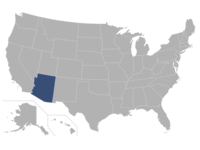Teachers union calls for $1.7 billion in new school funding

With legislators still undecided on how to spend the record $5.3 billion dollar budget surplus, the Arizona Education Association, the state’s largest teacher’s union, is demanding massive increases in education funding.
Heather Ayers, president of the Isaac District Association and a teacher at Joseph Zito Elementary School in Phoenix, said that the unwillingness of lawmakers to mobilize the surplus to support classrooms is frustrating for teachers, who feel left behind.
“(Schools) aren’t being valued. Our students aren’t being valued. Our families aren’t being valued, our teachers aren’t being valued,” she said.
The AEA this week released its “Educator’s Budget” to address those concerns, which calls for $1.2 billion in new ongoing funding for public schools and another $450 million in one-time spending. In addition to a $505 million increase to the basic education funding formula, the plan calls for creating new funding sources for schools through Tribal Student Weight, Opportunity Weight and Junior High Weight, each of which would allocate extra dollars to schools based on their student populations.
The plan also calls for more money for career and technical education programs, special education and pre-K. And full-day kindergarten — which was defunded in 2010, because of the Great Recession — would be restored.
These demands aren’t coming out of nowhere, said Marisol Garcia, vice president for the AEA. Schools and parents know that programs like full-day kindergarten work, and they’re sorely needed by communities all over the state. In previous years, the legislature has shortchanged schools, she said, citing a lack of funding — but that’s no longer an excuse.
The state has an unprecedented $5.27 billion budget surplus, which is roughly equivalent to about 40% of the current year’s budget.
Of that unplanned money, $1.57 billion is ongoing revenue, meaning it can be spent on permanent or multi-year programs without worrying about whether the funding will exist in the future. Another $3.7 billion is considered one-time money, which lawmakers generally use to pay for temporary programs, since there is no guarantee the tax revenue will exist after this year.
Teachers have shown up for students through a pandemic and an increasingly hostile legislative session, Garcia said, and now the ball is in the legislators’ court.
“(There) was a national movement to disparage and disrespect educators, and that time is over. Now is the time to rectify those conversations by investing in our students, educators and schools,” she said.
The AEA’s budget proposal includes a one-time funding boost of more than $447 million aimed at alleviating some of the most pressing issues in the state’s education system. About half of that would be used to repair and maintain school facilities across the state and implement broadband access in rural areas. The other half would be divided up into $2,000 bonuses for every teacher.
In a state that ranks near the bottom in teacher salaries and working conditions, retention is urgent. Isaac School District alone is estimated to lose 15% of its personnel this year, Ayers said. She warned that high turnover rates mean a lack of consistency for students.
“We are losing a lot of people in education and teachers just because we don’t pay enough,” she said.
As much as 78% of teacher positions in Arizona are vacant or filled by personnel that don’t meet standard teacher requirements, according to a January analysis. Part of the ongoing portion of the budget proposal is a $505 million dollar increase in base funding, which would help bolster teacher pay.
To critics who might balk at the proposal’s hefty price tag, Garcia said it’s a necessary step to remedy Arizona’s abysmal performance in education funding. The state is 47th in the nation in per-pupil funding. Ultimately, she said, supporting schools creates a positive rippling effect in the communities they serve.
“Strong schools equal strong communities…so (it) should be the very core of everything we invest in,” she said.








